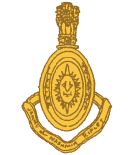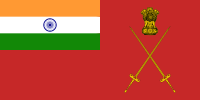Jammu and Kashmir Rifles
The Jammu and Kashmir Rifles is one of the most prestigious infantry regiment of the Indian Army. Its origins lay in the Jammu and Kashmir State Forces of the princely state of Jammu and Kashmir. After the accession of the state to the Indian Union in October 1947, the State Forces came under the command of the Indian Army. They remained in the original form until 1956 when Jammu and Kashmir Constituent Assembly effectively ratified the state's accession to India. Then the State Forces became the Jammu and Kashmir Regiment of the Indian Army.[2] In 1963, the designation was changed to Jammu and Kashmir Rifles. After the conversion, the Ladakh Scouts came under the aegis of the Regiment, where it remained until raised as a separate Regiment in 2002.[3]
| Jammu and Kashmir Rifles | |
|---|---|
 Regimental Insignia of the Jammu and Kashmir Rifles | |
| Active | 1821–Present |
| Country | |
| Branch | |
| Type | Light Infantry |
| Role | Infantry |
| Size | 19 battalions |
| Regimental Centre | Jabalpur, Madhya Pradesh |
| Motto(s) | Prashata Ranvirta ("Valour in Battle is Praiseworthy")[1] |
| War Cry | Durga Mata Ki Jai ("Victory to Goddess Durga")[1] |
| Decorations | See below |
| Commanders | |
| Colonel of the Regiment | Lt Gen Yogesh Kumar Joshi |
| Insignia | |
| Regimental Insignia | An oval embracing the sun, the State emblem. The Sanskrit inscription around the sun, which cannot be read on the regimental insignia above, translates as, "Ever Victorious in War"[1] |
History
The Jammu and Kashmir Rifles has a unique regimental history. Its antecedents go back to the Dogra Corps raised by intrepid Raja Gulab Singh of Jammu in 1821, under the suzerainty of Maharaja Ranjit Singh of Sikh Empire. General Zorawar Singh led daredevil campaigns in northern areas like Ladakh, Baltistan, Gilgit, Hunza and Yagistan, consolidating smaller principalities and making the northern areas a part of the expanding dominions of Gulab Singh. He also mounted a breath-taking invasion of Tibet in 1841.
After the establishment of Jammu and Kashmir as independent princely state under the British Paramountcy in 1846, these troops became the Jammu and Kashmir State Forces.
The Maharaja of Jammu and Kashmir maintained a larger number of State Forces than any other ruler of an Indian State under the British Raj. These forces were organized into the Jammu and Kashmir Brigades. They comprised a bodyguard cavalry regiment, two mountain batteries, seven infantry battalions, one training battalions and a transport unit consisting of both pack and mechanized transport. Several of these units served with distinction on the North-West Frontier of India and overseas during the Great War.[3] The state forces fought as Imperial Service Troops in both the First and Second World Wars (under their own native officers). They distinguished themselves in East Africa, Palestine and Burma.
Kashmir War of 1947
The regiment's grimmest hour came during the Indo-Pakistani War of 1947. It was their heroic stand that gained time for the entry of the Indian Army and thus saved the Kashmir Valley. It may not be out of place to mention that the Indian people largely owe the State of Jammu and Kashmir to the heroic defensive stand made by the outnumbered and ill-equipped, but highly motivated, J&K State Force. They paid a steep price in blood and sacrificed over 76 officers, 31 JCOs and 1085 Other Ranks. For their gallant stand they earned three Maha Vir Chakra, 20 Vir Chakras and 52 Mentioned in Despatches. Later the Jammu and Kashmir State Force was absorbed en bloc into the Indian Army as a separate regiment.
Sino-Indian War of 1962
Two battalions of Jammu and Kashmir Rifles constituted the main fighting force of India in Aksai Chin during the Sino-Indian War of 1962. Supplemented by a battalion of the regular Indian Army, they fought "very well" according to scholar Steven Hoffman. China attacked them with a massive force of an entire division.[4]
Recruitment
Much of the Army's Jammu and Kashmir Light Infantry and Jammu and Kashmir Rifles Regiments are made of recruits from the districts of Jammu, Samba, Kathua, Udhampur, and Reasi, while other districts like Poonch, Rajouri, Doda and Kishtwar also contribute .[3] Soldiers from Himachal Pradesh, Punjab and Haryana also contribute to the ranks.
Units
In 1947, the force had 9 infantry battalions and a cavalry regiment. It was subsequently raised to 21 battalions. The 16th Battalion has been reassigned as 14th Battalion of the Mechanised Infantry Regiment[1]
Battle honours
- Defence of Chitral
- The Great War: Megiddo, Sharon, Nablus, Palestine 1918, Kilimanjaro, Beho Beho, East Africa 1914–17
- The Second World War: Kennedy Peak, Defence of Meiktila, Burma 1942–45
- Punch, Skardu, Jammu and Kashmir 1947–48, Battle of Asal Uttar, Punjab 1965
- 1971: Shyam Ganj, East Pakistan 1971
- Point 5140, 4875, Rocky Knob during Kargil War 1999.
Note: Pre-1948 honours inherited from several battalions of Kashmir State Forces.
Decorations
Param Vir Chakra
- Captain Vikram Batra (posthumous) 13th Battalion – Kargil, 1999[5]
- Rifleman Sanjay Kumar, 13th Battalion – Kargil, 1999[6]
Maha Vir Chakra
- Brigadier Rajendra Singh Jamwal, J&K Rifles – Kashmir, 1947
- Brigadier Sher Jung Thapa, 13th J&K Rifles – Skardu, 1947
Other Awards
- 2 × Param Vir Chakra
- 2 × Ashok Chakras
- 1 × Padma Bhushan
- 3 × Param Vishisht Seva Medals
- 5 × Maha Vir Chakras
- 11 × Kirti Chakras
- 4 × Ati Vishist Seva Medals
- 44 × Vir Chakras
- 46 × Shaurya Chakras
- 1 × Uttam Yudh Seva Medal
- 313× Sena Medals
- 2 × Yudh Seva Medals
- 31 × Vishisht Seva Medals
- 52 × Mentioned in Despatches
- 243 × COAS Commendation Cards
- 101 × Army Commanders Commendation Cards[1]
References
Citations
- "The Jammu and Kashmir Rifles". bharat-rakshak.com. 2014. Archived from the original on 19 February 2014. Retrieved 18 February 2014.
- Brahma Singh, History of Jammu and Kashmir Rifles 1990, pp. 278–279.
- "Jammu and Kashmir Rifles". globalsecurity.org. 2014. Retrieved 18 February 2014.
- Hoffmann, Steven A. (1990), India and the China Crisis, University of California Press, p. 103, ISBN 978-0-520-06537-6
- Rawat 2014, p. 264.
- Rawat 2014, p. 254.
Bibliography
- Rawat, Rachna Bisht (2014). The Brave: Param Vir Chakra Stories. Penguin Books India Private Limited. ISBN 9780143422358.CS1 maint: ref=harv (link)
- Singh, K. Brahma (1990), History of Jammu and Kashmir Rifles, 1820-1956: The State Force Background, Lancer International, ISBN 978-81-7062-091-4
Further reading
- Palit, D. K. (1972), Jammu and Kashmir Arms: History of the J & K Rifles, Palit & Dutt
- Manju Khajuria, Why we must not forget J&K state forces who fought World War I, Daily O, 7 November 2015.
